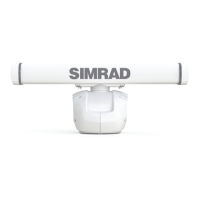8 |
Introduction |Halo pulse compression radar installation manual
Introduction
This manual explains how to install the Halo® Pulse Compression Radar system. This manual
should be used in conjunction with the installation manual provided with the display.
This manual is written for professional marine technicians, installation technicians, and service
technicians. Dealers may use information contained in this document.
The Halo® Pulse Compression Radar combines the best characteristics of traditional pulse and
FMCW broadband radar systems, our Halo™ Radar uses Pulse Compression technology to
provide an unprecedented mix of long and short detection range, high target denition, and
minimal clutter. Solid State technology means minimal warm-up time and maximum ocean-
going reliability, while compliance with upcoming Low Emission standards makes Halo Radar
safe to run in anchorages and marinas
The radar system consists of a pedestal, antenna, RI-12 radar interface and connection cables.
An Ethernet network cable is used to connect the RI-12 radar interface module to the navigation
Ethernet network and is intended for use in a marine environment.
¼ Note: Antennas are available in three sizes 3 ft, 4 ft and 6 ft to suit customer requirements.
¼ Note: At the time of release the Halo radar will only work with Simrad NSSevo2 and NSOevo2
systems
¼ Note: The radar should be installed by a qualied radar technician.
Warnings
Warning: Use the radar at your own risk. Your radar is designed as a navigation aid.
Always compare the navigation information received from your radar with data from other
navigation aids and sources. When a conict arises between the navigation data from
your radar and data from other navigation aids, make sure you resolve the conict before
proceeding with navigation.
A CAREFUL NAVIGATOR NEVER RELIES ON ONLY ONE METHOD TO OBTAIN NAVIGATION
INFORMATION.
International Regulations for Preventing Collisions at Sea mandate that when radar is on
a vessel, the radar must be used at all times, regardless of weather conditions or visibility.
Numerous court decisions have ruled that the radar must be used, and the radar operator
must know all operational aspects of radar performance. Otherwise they will face a greater
risk of liability if an accident occurs.
Warning: High Current, Stored and Microwave Energy Hazard. Technicians must
exercise extreme care when working inside the unit. ALWAYS remove power before removing
the cover. Some capacitors may take several minutes to discharge, even after switching o
the radar. Before touching any high voltage components, ground them with a clip lead.
Warning: Halo™ Pulse Compression Radar’s blue 4 level static accent pedestal lighting
may not be approved for use in your boating location. Please check your local boating
regulations before turning the blue accent lights ON.
Warning: The microwave energy radiated by a radar antenna is harmful to humans,
especially to the eyes. NEVER look directly into an open waveguide or into the path of
radiation from an enclosed antenna. Remove power or use the Safety switch on the rear
of the Pedestal to turn o the radar whenever it is necessary to work on the antenna unit or
other equipment in the beam of the radar.
1

